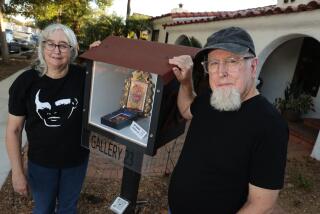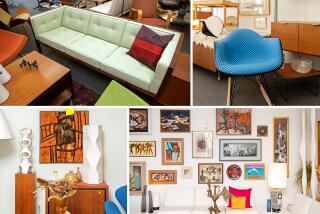After His Probate Sales, No One’s Complaining
- Share via
RESEDA — On any given Friday, auctioneer Doug Carr can be found standing on a small wooden stage in his Sherman Way store, hawking everything from dining-room sets to power tools.
As the owner and auctioneer of Pacific Auction Gallery, Carr, 39, is the kind of adrenaline-charged firebrand who can auction 1,000 items over a four-hour period--he takes no breaks--and then hop on a plane bound for England to act as auctioneer over three grueling 10-hour days at an auction house in Wigan.
And then it’s back to Reseda in time for the next Friday auction.
The merchandise he sells comes mostly from probate lawyers who are dispersing an estate after a death. He prefers probate sales to individual consignments, because those sellers are often disappointed about the price an item fetches.
“People always think their stuff is worth more, or that I didn’t get them enough money,” he said.
That doesn’t happen with a probate sale, noted Carr, who said he has standing agreements with several lawyers to dispose of estates.
“We sell it for whatever it sells for,” he said. “We offer no guarantees, we offer no reserves and we don’t really deal with dealers. The no-reserve part usually makes them [dealers] shy away.”
A reserve is a minimum sale price, giving sellers the option of pulling an item back if they don’t get their minimum. Since Carr refuses to offer reserves, buyers at his auctions can pick up some pretty good deals.
“I bought an 1860s Victorian vanity table for $400,” said Linda Griffith, a Sunland resident who frequents Carr’s auctions. “And before I left the building, a decorator offered to pay me $1,800 for the vanity. I turned her down and later had the vanity appraised at $2,900.”
Stories like that seemed to abound among those attending one recent Friday auction.
“I had been looking for a solid oak dining-room table and chairs that I saw in a store for more than $900,” says Patty Coryell, a San Dimas resident. “I found it here for $190.”
Several people admitted they were there to buy items that they would then try to sell on Ebay, the online auction service.
In order to bid on items, people have to register their name, address and phone number beforehand; dealers have to give their resale number. Payment is by cash or credit card.
“Most people are happy with their purchases,” Carr said, “and occasionally people will bid on an item and then not come to pick it up or pay.”
In those instances, Carr said he will usually just resell the item.
“We’ll call them up and they usually have some excuse. I don’t generally try to force them to buy it. I just don’t know that I’ll give them a bid card again.”
And to be more customer-friendly, Carr said the gallery also accepts phone bids. This requires one of Carr’s employees to stay on the phone with bidders and make bids on their behalf.
He also allows absentee bids, whereby people can come by before the auction and leave bids on items. If they aren’t outbid, they get the piece.
*
He has 15 full-time staff members and 15 part-timers who do everything from move furniture to register bidders to scan the audience for raised bid cards.
Marketing includes advertisements in the newspaper, brochures (mailed to 20,000 local residents) and word of mouth.
“We have five to 10 new faces show up every Friday,” he said. “And most of them have never been to an auction before.”
Carr’s decision to open his own auction house was circuitous. He moved to Los Angeles in 1985 and became an officer with the Beverly Hills Police Department.
“I was only with the department for a couple of months and I was shot in the leg,” he said. “That woke me up. I didn’t want to have to deal with punk kids.”
So he turned to dealing in antiques. He rented a store and, over time, began auctioning items out of a warehouse in Valencia. He said his first auction grossed $5,000.
“I started out very small and no one was bankrolling me,” he said.
He soon decided his business was too far from the center of Los Angeles and relocated to the San Fernando Valley.
“I needed a location that was considered part of Greater Los Angeles,” he said. “And I needed a lot of room and a lot of parking.”
*
What he came up with was three buildings totaling more than 50,000 square feet of retail space on Sherman Way. At his Friday auctions, held in the small 9,000-square-foot location, he grosses $20,000 to $30,000.
In addition to his Friday auctions--in which he sells mostly furniture and bric-a-brac--Carr also hosts a once-a-month art and antiques auction, a two-day event that usually falls on the first weekend. Those can gross several hundred-thousand dollars, depending on the merchandise.
“That’s a pretty fancy and elaborate deal,” he said. “We furnish 10 different rooms and put everything out. The china goes on the table, the art on the walls, to give people an idea what their homes could look like.”
And even though he may don a tuxedo for that event, Carr said he’s building his company’s identity on being a “down-to-earth” auction house.
“We’re not uppity and snooty. And still we sell quality merchandise. It’s just that we make it a social event,” he said. “People come to have fun.”
That style of auctioneering, cracking jokes and all, is something Carr picked up as a child, growing up in an auctioneering family in Rockford, Ill.
“There’s no such thing as an estate sale in the Midwest,” he said. “People just go to the auction.”
And although he takes delight in serving up his down-home approach, he also is looking toward the day when his company is as highly regarded as other auction houses.
And he’s hoping that one painting, what he calls a lost Cezanne, will further establish his reputation.
*
“It’s your basic story of a young family who inherited this painting from an uncle,” he said.
Carr is having the painting appraised by officials at the Louvre museum in Paris.
“When we get that authentication,” he said, “then everyone is going to know about this little auction house.”
More to Read
Inside the business of entertainment
The Wide Shot brings you news, analysis and insights on everything from streaming wars to production — and what it all means for the future.
You may occasionally receive promotional content from the Los Angeles Times.










